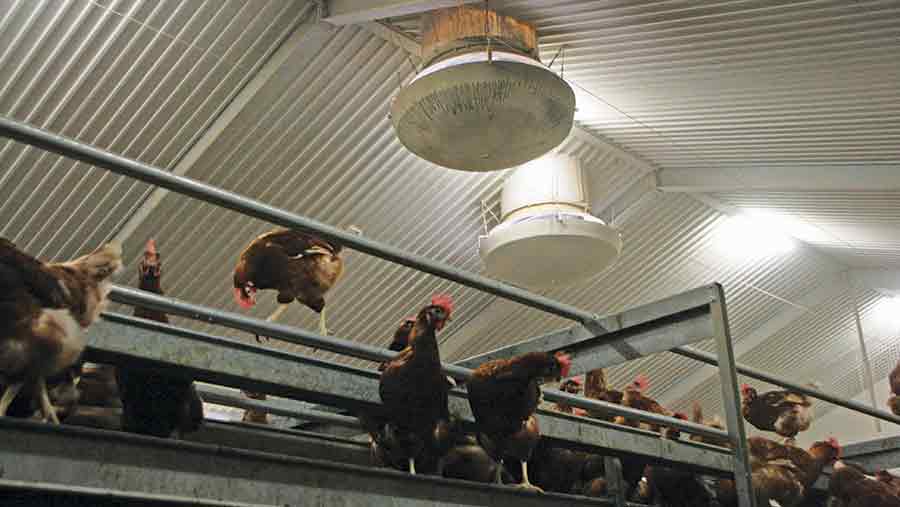Tips on ventilation to aid layer performance

When it comes to ventilation on larger layer units, attention to detail pays dividends, as Lasse Kiel-Madsen of Swedish climate control specialists Munters explains.
Whether a layer farmer is based on enriched cages, barn or free-range production, providing suitable ventilation is essential to optimise hen comfort and so enhance egg quality and improve the number of hen days.
If there is a sudden cold spell, for example, the system needs to be able to add the right amount of heat. And if there is a heatwave, it must be able to extract air to prevent heat stress.
Furthermore, there should be a back-up system in case there is a power loss, so inlets and fan dampers can be opened, so preventing birds from smothering and suffocating.
See also: Optimising air flow for layers
When installing a ventilation system, the first thing to take into consideration is the ambient climate of the specific location.
Average winter and summer temperatures, as well as humidity levels and likely wind speeds, should be carefully collected and investigated.
The control at the heart of the system will be configured so that it responds to any changes.
In large hen houses there will be several design challenges, which are more or less unique to every situation. But it is possible to outline some general objectives, too.
Uniformity
One is to create uniformity, especially in a barn or free-range production system, where hens are free to move around the building.
Uniformity means there must be no cold or warm spots in the house.
If that occurs during cold periods, the hens will cluster around warmer spots and there is a risk of disturbances, overload on the egg handling system or fighting in the flock.
The same scenario of clustering will occur during warm periods if there are cold spots, likewise creating an imbalance in the house.
Uniformity always starts with placement of the climate equipment for an even distribution of fresh incoming air and taking stale air out of the house.
The type of inlet chosen depends of the climate conditions where the house is located.
If the incoming air is cold for a period of the year, one generally wants to avoid that cold air dropping down directly towards the birds, as this will inevitably disturb them.
For these cases, a horizontal and radial spread of air is desired, mixing it with warmer air next to the ceiling before it drops down on the flock.
Attention also needs to be paid to the distance between the ceiling air inlets so that the optimum air flow inside the building can be reached.
Bedding quality
The second challenge for a climate control system is bedding quality, at least for barn and free-range production systems where birds move around on the floor. This typically consists of straw, wood shavings or sand.
The farmer wants the bedding material to remain dry so that it does not stick to the birds’ feet and ends up in the nests, thereby causing dirty eggs that the farmer will not get paid for.
Wet bedding material mixed with manure will also increase the ammonia levels inside the house, affecting both animals and people negatively.
A well-ventilated building, with sufficient air flow and heating as needed, will ensure that the bedding material is kept dry, creating a better environment for the birds and improved profits for the farmer.
Floor eggs
The third challenge for the layer farmer is floor eggs and how to avoid them. It is a cumbersome job to collect these several times a day – man hours that could be used for other jobs on the farm. Floor eggs also lead to lost income.
To discourage floor eggs, the ventilation design needs to make sure that there are no drafts in the nesting areas of the layer house.
As long as this is a comfortable zone for the hens, this is where they prefer to lay their eggs and this means that the egg handling system will take care of the product.
Light control
The fourth climate challenge is light control. Getting at least eight hours of sleep is crucial for the hens, especially during summer in the northern hemisphere. Pitch-black is not necessary, but a brownout effect is.
Light spots on the floor or in cages are something the farmer should avoid since it prevents the chickens from falling asleep.
Light spots can be avoided by carefully designing the climate control system. Drip pans underneath chimney fans can help, as can deflector disks which reflect the light from inlets back up towards the ceiling or walls.
By properly configuring the climate system and equipping each project with the products and controls suitable for that specific location, we can make sure that the farmer doesn’t end up with exhausted birds that don’t thrive or perform well.

